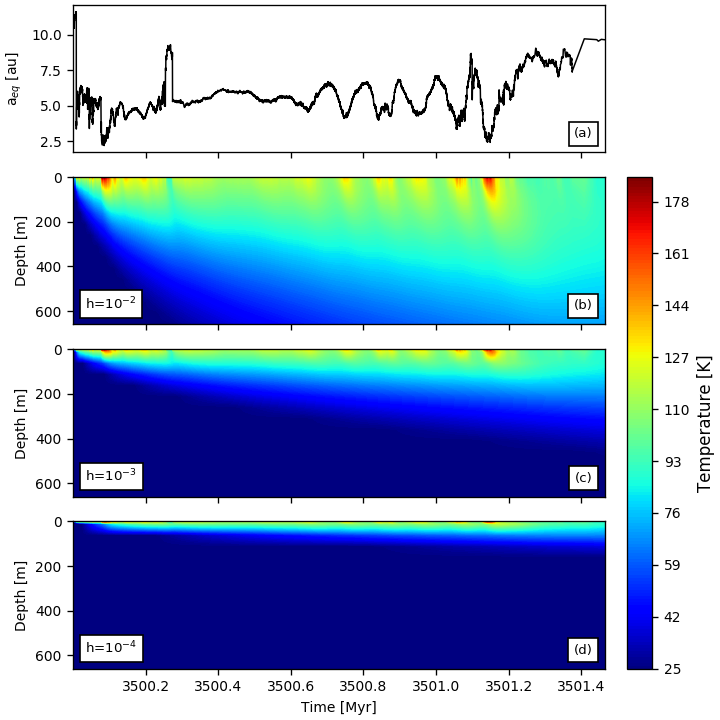Preliminary study of the coupled long-term thermal and dynamical evolution of JFCs
- 1Univ Lyon, UCBL, ENSL, UJM, CNRS, LGL-TPE, F-69622, Villeurbanne, France (anastasios.gkotsinas@univ-lyon1.fr)
- 2Laboratoire d’Astrophysique de Bordeaux, France
- 3Southwest Research Institute, Boulder, USA
Introduction
Comets are often referred to as the most pristine objects in our Solar System. Formed during the early stages of our planetary system and preserved in its coldest outskirts, comets are considered to be extremely well preserved remnants of the Solar Nebula [1]. However in the Kuiper Belt, comet nuclei may be heated at temperatures up to 30-50 K [2]. In addition, from the moment of their first ejection from their reservoirs, to the moment of their detection and observation, an important period of time remains unaccounted for, from a thermal evolution modeling point of view. In fact, constraining the journey of a comet nucleus towards the inner parts of the Solar System is not a straight forward procedure, since it is chaotic due to close encounters with giant planets [3]. We seek to investigate this intermediate stage in the dynamical evolution of comets and its potential effects on their thermal evolution, as we believe that significant thermal alterations can take place, as evidenced by the existence of active Centaurs [4].
Methods
We aim to get a first-order assessment of the extent of thermal processing of comet nuclei during their dynamical evolution from the Kuiper Belt to the inner Solar System. We apply a 1D thermal evolution model in order to resolve the heat diffusion equation and obtain the temperature profiles in a comet nucleus [5]. To simplify the problem, which is complex due to the very different timescales involved for the various processes, we neglect in this preliminary work any ice phase transition (sublimation or crystallization). Thermo-physical parameters are otherwise standard [6]. A special consideration has been taken for the thermal conductivity, the most critical parameter in this study, with three values of the Hertz factor (h) used to account for the geometry of contact between grains. This simplified model is applied to a sample of 276 dynamical clones, all representative of active JFCs, with perihelion distances within 2.5 au [3].
Results
For each clone, we observe several, long-lasting passages close enough to the Sun for the nucleus to be significantly altered. Those are spread throughout the clone's dynamical evolution, resulting in the heating of a significant subsurface layer. We note that the radial extent of this layer is strongly related to the thermal conductivity of the porous medium, which in its turn depends on the selected geometrical scenario. A statistical analysis, performed for all values of the thermal conductivity considered, shows that the sublimation temperatures of the main volatile components of comets (CO, CO2, H2O) can be reached, sometimes down to the innermost parts of the nucleus. In this context, most clones might lose an important fraction (yet to be determined) of their volatile content.
Perspectives
This preliminary work suggests that a comet's orbital past may result in a significant thermal processing of the nucleus. Further work will be performed to fully constrain the extent of such processing.

Acknowledgments
This study is part of a project that has received funding from the European Research Council (ERC) under the European Union’s Horizon 2020 research and innovation programme (Grant agreement No. 802699). We gratefully acknowledge support from the PSMN (Pôle Scientifique de Modélisation Numérique) of the ENS de Lyon for the computing resources.
References
[1] Filacchione et al. (2019) SSRv, 215, 46
[2] Prialnik et al. (2004) in Comets II, Festou, Keller, Weaver (Eds.), 359
[3] Nesvorny et al. (2017) ApJ, 845, 25
[4] Jewitt (2009) AJ, 137, 4296
[5] Guilbert-Lepoutre et al. (2011) A&A, 529, 71
[6] Huebner et al. (2006) Heat and Gas Diffusion in Comet Nuclei (Published for The ISSI)
How to cite: Gkotsinas, A., Guilbert-Lepoutre, A., Raymond, S., and Nesvorny, D.: Preliminary study of the coupled long-term thermal and dynamical evolution of JFCs, Europlanet Science Congress 2021, online, 13–24 Sep 2021, EPSC2021-228, https://doi.org/10.5194/epsc2021-228, 2021.

